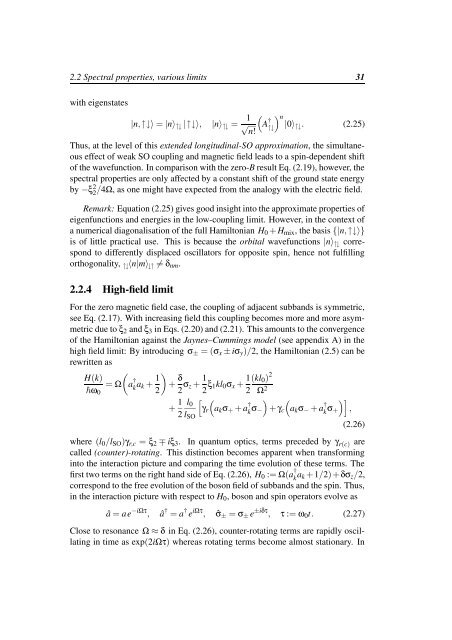Spin-orbit coupling and electron-phonon scattering - Fachbereich ...
Spin-orbit coupling and electron-phonon scattering - Fachbereich ...
Spin-orbit coupling and electron-phonon scattering - Fachbereich ...
You also want an ePaper? Increase the reach of your titles
YUMPU automatically turns print PDFs into web optimized ePapers that Google loves.
2.2 Spectral properties, various limits 31<br />
with eigenstates<br />
|n,↑↓〉 = |n〉 ↑↓ |↑↓〉, |n〉 ↑↓ = 1 √<br />
n!<br />
(A † ↑↓) n<br />
|0〉↑↓ . (2.25)<br />
Thus, at the level of this extended longitudinal-SO approximation, the simultaneous<br />
effect of weak SO <strong>coupling</strong> <strong>and</strong> magnetic field leads to a spin-dependent shift<br />
of the wavefunction. In comparison with the zero-B result Eq. (2.19), however, the<br />
spectral properties are only affected by a constant shift of the ground state energy<br />
by −ξ 2 2 /4Ω, as one might have expected from the analogy with the electric field.<br />
Remark: Equation (2.25) gives good insight into the approximate properties of<br />
eigenfunctions <strong>and</strong> energies in the low-<strong>coupling</strong> limit. However, in the context of<br />
a numerical diagonalisation of the full Hamiltonian H 0 +H mix , the basis {|n,↑↓〉}<br />
is of little practical use. This is because the <strong>orbit</strong>al wavefunctions |n〉 ↑↓ correspond<br />
to differently displaced oscillators for opposite spin, hence not fulfilling<br />
orthogonality, ↑↓ 〈n|m〉 ↓↑ ≠ δ nm .<br />
2.2.4 High-field limit<br />
For the zero magnetic field case, the <strong>coupling</strong> of adjacent subb<strong>and</strong>s is symmetric,<br />
see Eq. (2.17). With increasing field this <strong>coupling</strong> becomes more <strong>and</strong> more asymmetric<br />
due to ξ 2 <strong>and</strong> ξ 3 in Eqs. (2.20) <strong>and</strong> (2.21). This amounts to the convergence<br />
of the Hamiltonian against the Jaynes–Cummings model (see appendix A) in the<br />
high field limit: By introducing σ ± = (σ x ± iσ y )/2, the Hamiltonian (2.5) can be<br />
rewritten as<br />
H(k)<br />
ω 0<br />
= Ω<br />
(<br />
a † k a k + 1 2<br />
)<br />
+ δ 2 σ z + 1 2 ξ 1kl 0 σ x + 1 (kl 0 ) 2<br />
2 Ω 2<br />
+ 1 l<br />
[ 0<br />
γ r<br />
(a k σ + + a †<br />
2 l<br />
k σ −<br />
SO<br />
) (<br />
+ γ c a k σ − + a † k σ +<br />
)]<br />
,<br />
(2.26)<br />
where (l 0 /l SO )γ r,c = ξ 2 ∓ iξ 3 . In quantum optics, terms preceded by γ r(c) are<br />
called (counter)-rotating. This distinction becomes apparent when transforming<br />
into the interaction picture <strong>and</strong> comparing the time evolution of these terms. The<br />
first two terms on the right h<strong>and</strong> side of Eq. (2.26), H 0 := Ω(a † k a k +1/2)+δσ z /2,<br />
correspond to the free evolution of the boson field of subb<strong>and</strong>s <strong>and</strong> the spin. Thus,<br />
in the interaction picture with respect to H 0 , boson <strong>and</strong> spin operators evolve as<br />
â = ae −iΩτ , â † = a † e iΩτ , ˆσ ± = σ ± e ±iδτ , τ := ω 0 t. (2.27)<br />
Close to resonance Ω ≈ δ in Eq. (2.26), counter-rotating terms are rapidly oscillating<br />
in time as exp(2iΩτ) whereas rotating terms become almost stationary. In
















